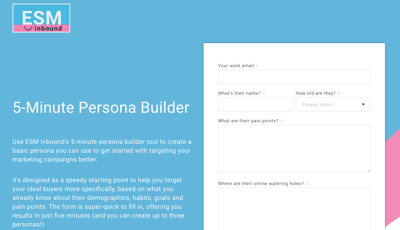3 ways to climb out of your content rut
3 ways to climb out of your content rut
Receive our weekly email
Hands up who’s been creating the same content for some time now... don’t be shy, you’re amongst friends. It’s a rut we all fall into from time to time, but with so many forms of communication to utilise in helping you get more leads, can you afford to create ‘Groundhog Day’ content?
Customers and prospects grow blind to content after a while – if you don’t mix up your style, tone or form every once in a while, the incentive to access your content vanishes. On a recent creative day at The Guardian, leading journalist Andy Pemberton explained:
“Even your target audience doesn’t really want to read your content – don’t underestimate how uninterested people are. 100% of people read a headline, 10% read to the end.”
Depressing though this might sound: it’s true. From the moment your audience starts reading, watching or listening to your content, they’re looking for reasons to go and do something else. How are you going to engage them until the end? We all want that 10% of the audience left at the end of our content to actually be 100%.
While your existing content offers might be great, working really well at increasing leads, there’s a chance you’re itching to try something new, just not sure how to go about it. Content can generally be split into three groups – interactive, video & audio, and downloadable– you’re probably doing at least one of them well already. Here are some fresh ideas to try for your next offer.
Meet your future content
Creating interactive content, moving image or audio pieces might feel like an uncertain step in a new direction, but like with anything: you get better with practice (and it’s really not as overwhelming as you might first think – writing ebooks was once new to you, remember?)
We live in a world where being a passive looker-on is no longer the norm. Whether it’s searching for holidays, finding a new job or buying the best-value dining table, we go out searching for our purchases. We don’t go through a travel or job agency, and we don’t wait for the door-to-door furniture salesman to drop by – we don’t even visit the store.
We want options at our fingertips and quick answers. But more than that, we want to interact with our content, ensuring the answers we are getting are personalised to us. Writing for HubSpot, Edward Ford from Nordcloud, highlights the benefits of using interactive content in your inbound marketing strategy, saying:
‘Rather than just sharing our thoughts with others, is there a way for them to share theirs with us? Can we move from a monologue to a dialogue? The answer to all those questions is interactive content.’
He goes on to explain how interactive content helped them drive leads up by 47% – and the desire for increasing leads is one thing all businesses have in common. There are so many types of interactive content now, that at least one form is bound to suit your business. Below, we look at just three of the easiest to create.
Group 1: Interactive content
Quizzes and questionnaires: Try leading your prospect through a short series of questions which result in a tailored outcome at the end: this can be used to help them identify and give a name to their pain point, help them consider all the options open to them to solve it, or help them make a decision about which product in your offering is right for them.
We love using Typeform to create quick, easy questionnaires that look beautiful, but you could also try Survey Anyplace.
Gamification: Everyone loves games. Especially when we are supposed to be doing something relatively dull – such as choosing wallpaper – but the process is turned into a fun task. And remember: people love competition, too – if you introduce a competitive element to a game with a prize at the end of it, people will turn up, take part and interact even better with your brand. Here’s how 15 different gamification tools shape up.
Calculator or other free tool: Being a marketer, you probably love numbers, but most people don’t. Removing all the hard work from a job – such as working out take-home salary – by just asking a few questions, means users will love your tool. Think about the sums required by many of your audience: if you can create an automated, engaging tool to do the work for them, with quick and accurate results, they’ll want to share it with everyone they know.
Check out our 5-minute persona builder tool as an example:

Here are some other top tools you can use to set up your first piece of interactive content.
Group 2: Moving image/audio
Videos: There are so many different types of video content out there – so many ideas you could play around with which can seem overwhelming. It’s been predicted that:
‘By 2019, 80% of global internet consumption will be video content.’
We can all relate to this; with 5 billion videos being viewed on YouTube every day, there’s a staggering amount of content out there. This can mean that consumers become less sensitive to video advertising (which means your has to be really useful to stand out). This doesn't mean the production and editing costs have to be level with a Beyoncé music video, in fact Vidyard has put together this helpful resource to walk you through your first steps with video content, and it's not as expensive or difficult as you think.
Podcasts: In case you aren't familiar with this form, podcasts are an episodic series of audio files which a user can download in order to listen to them on the go. As we explored in our previous blog post about creating content your audience wants to come back for – podcasts are on the rise. All age groups and genders are experiencing an increase in engagement with podcasts, but in particular, the 15-24 age group has really rocketed: if your typical audience is within this age bracket, it's really time to listen up to podcasts.

At ESM Inbound, we are big fans of the humble podcast (It's verging on an obsession for me!) Here's a super-helpful guide to creating your own podcast for the first time.
Social media: A great place to host your quizzes, surveys, videos and latest episodes of podcasts, social media can also act as an interactive content tool all on its own. You can create polls where audiences vote on certain images or to help you make decisions about the direction of your content, and encourage users to upload their own images and videos using your hashtags so content is categorised.
Even something as simple as running a caption competition for an image you upload to social channels with a prize for the winner – a concept that is decades old – is a great way to engage your audience through social. Here are some examples of successful interactive content from social media.
Group 3: Printable and downloadable content
Case studies: One of the most valuable forms of content you can create – people are really, genuinely interested in case studies. Another interesting fact I learnt from Andy Pemberton at The Guardian was that:
"Case studies have an 83% finish rate! People like reading about real people who are like them. 300 words is prime length for a case study – don't overdo it: be succinct."
Contact one of your super-duper customers, someone who you've built a real rapport with and have concrete data to shout about and back up your points. Ask them for a phone interview (and make sure you get their permission to record so you can transcribe it later.)
Either create a case study as a PDF for download, or house as a webpage behind a form – the only problem will be keeping it to that magic 300 words. Here's HubSpot's shortlist of fantastic case studies everyone needs to see to get started.
Posters, checklists and timelines: The majority of people still work in offices. And the majority of those offices still have blank walls. Help people fill them with useful content! Yes, providing a poster or checklist resource might feel dated, but if people are still making use of them – what’s the problem? Engaging some of our tips from other sections, you might decide to make the poster a game, quiz or fun countdown with spaces for the user to tick off. Using a tool like Piktochart will help you build fun infographics and posters.
Ebooks: The ebook is not dead. People still like to bookmark something and return to it. An alternative though, could be a pillar page. In a similar way to an ebook, these tend to be at least 3,000 words of content, split into chapters on one specialist subject: so far, so good. The difference is, instead of putting this content behind a gated landing page (although you can still do this if you like) your pillar page is housed on your website for everyone to find. Find out more about building your first pillar page and the successes they create.
Mix it up
Why try new content?
Experimenting with different types of content doesn’t just potentially benefit your audience, it might inject something into your role that you’ve been missing. You might find you communicate more passionately about your product and the mission behind your business when you say it into a microphone or have a video recorder in front of you.
And how do you know what your audience likes unless you trial it? There are lots of ways to find out more about your buyer persona’s watering holes – the places they hang out and the content they enjoy accessing. Conducting this research is really important. But having the courage to put something different out there is just as important.
Be brave. Try a new style of content for your next offer. Measure the uptake against your last campaign’s results. If it doesn’t do well – then you’ve learnt a lesson. But if you never try it, you won’t learn a thing.
Build your HubSpot integration
SpotDev's team of UK-based experts can create a custom integration to connect your systems.
Learn about integrationsESM Inbound's content includes affiliate links. This means that we may receive a commission if you make a purchase through one of the links on our website. This will be at no cost to you and helps to fund the content creation work on our website.